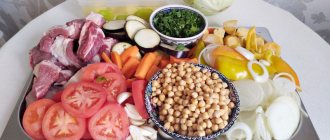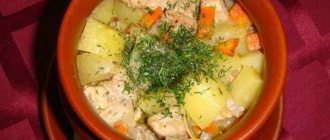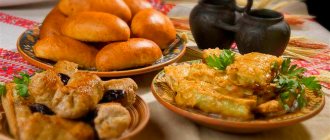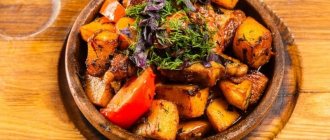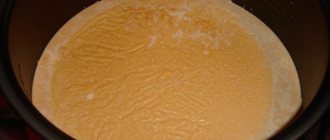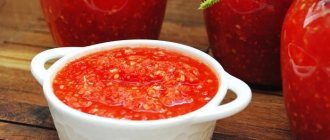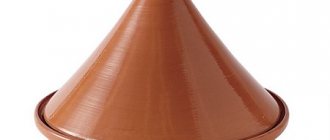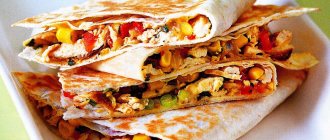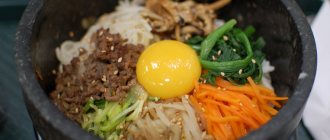Uzbek cuisine is a tradition of cooking that goes back centuries, but is open to innovation and changing to suit modern conditions.
It was only in the 19th century that vegetables began to be grown in Uzbekistan, and less than 100 years later, basma and domlama became the hallmark of the region. Recipes for vegetable salads appeared. They go perfectly with a set of traditional recipes of Uzbek cuisine - pilaf, mastava, pastries. The Uzbek cuisine is noticeably different from the cooking of neighboring nomadic peoples: the life of this people has not been purely nomadic for a long time, which has made it possible to significantly diversify the menu with dishes, the preparation of which requires a large number of kitchen utensils or a stationary oven. But the ingredients are similar throughout Central Asia. This is meat, dough and vegetables. Do you like Uzbek cuisine?
Pilaf
A traditional dish of rice and meat, Fergana, Samarkand, Bukhara and Tashkent are fighting for the right to create the classic recipe. Pilaf is an essential component of holiday meals. Not a single significant event in Uzbekistan is complete without it.
Traditionally, men prepare pilaf. Although we are accustomed to the fact that its main ingredient is rice, it can be replaced by wheat or even special pasta. Chickpeas are often added, replacing rice in whole or in part.
Many are sure that the best ingredient for pilaf is lamb. But both beef and poultry will do, as long as it’s of high quality. The priority of lamb is determined not only by the culinary preferences of the Uzbeks, but also, not least, by the fact that lamb is more expensive than beef (yes, in Uzbekistan too!), and for a special occasion special products are needed, because pilaf is a festive food.
Most often, Uzbek pilaf is cooked from start to finish in one bowl, and only in the Bukhara method, rice is made using the folding method (the Bukhara people themselves call this method Kabul).
Here is a step-by-step recipe for almost any pilaf:
- calcinate the fat - vegetable or tail fat,
- by frying onions, carrots and meat, they make zirvak,
- add spices - pepper, salt, always cumin, often barberry, the rest is up to the choice of the cook,
- They put in rice, most often the devzir variety, but if the pilaf is folding, jasmine or basmanti are better suited.
The finished pilaf is served on a large flat dish, forming a mound.
This form of presentation looks great in photographs. Traditionally, it is eaten with your hands, but the restaurant may serve it using European cutlery. You can serve the pilaf with chopped vegetables and herbs.
They wash it down with plenty of tea: according to Uzbeks, this drink allows you to enjoy your meal to the fullest
Lagman
Homemade noodles with vaja - a gravy made from meat and a large amount of vegetables - are a frequent guest on the tables of Uzbek families. It is the variety of plant components that most clearly distinguishes the Uzbek recipe from its neighbors. But if you look closely, other differences will become noticeable: the noodles are used not pulled, but cut, and the gravy is thinner, and as a result the dish is more like a soup than a hot dish.
The noodle dough is made from flour and eggs with the addition of salt and water. The presence of round, stretched pasta in the lagman does not violate the traditional nature of the dish; it is not prohibited by the canon. It’s just that few people in Uzbekistan eat noodles; here they prefer to cut them.
Starting to prepare vaji is similar to preparing zirvak, but there are differences in the ingredients. Tomatoes are thrown into the vaja, then water is added, and cabbage and potatoes are boiled in the resulting broth. All this is poured over freshly boiled noodles right before serving. By the way, this helps to regulate the amount of liquid to taste.
Uyghur lagman
A Uyghur dish that is especially popular in Uzbekistan, Kyrgyzstan, Kazakhstan and western China. Consists of noodles, which are traditionally made by hand, and beef with vegetables. The meat is cut into thin layers, fried over high heat and onions, Chinese cabbage, celery, radishes, bell peppers, tomatoes and spices are added to it (each cook has his own set of spices, but among all the spices, star anise (anise) stands out especially). Uighur lagman is always served separately with “laza” - a spicy sauce made from dried red pepper, garlic and sunflower oil.
Manti
Festive steamed dough dish stuffed with meat and vegetables. It is perfectly stored frozen, which means it can help out the hostess in case of sudden arrival of guests. Manta rays are well known throughout the former USSR and are considered food for special occasions.
Uzbeks add additional ingredients to the classic minced meat made from onion, lamb and fat (tail fat or butter): beef tenderloin, pumpkin, and sometimes potatoes. It would not be a deviation from the classic recipe to fry the manti in vegetable oil before or immediately after cooking.
Manti is served with various sauces - tomato, sour cream, horseradish, mustard or simply with melted butter.
Login to the site
Uzbek cuisine
Basma
Basma - Uzbek science fiction! I can immediately say that this dish of meat and vegetables is very easy to prepare, there is no hassle with it, but it is extremely tasty on the table!
meat, onions, potatoes, carrots, cabbage, garlic, tomatoes, eggplant, beets, bell peppers, hot peppers, cucumbers, salt, cumin, parsley, dill, cilantro, basil
Khanum (lazy manti)
This dish was prepared the way my husband cooked it - the taste and recipe of his childhood. Very tasty and satisfying, and the main thing in the khanum recipe is its simplicity.
flour, eggs, water, salt, meat, potatoes, onions, butter, salt, seasoning
Chuchvara
Chuchvara - Uzbek dumplings, made from minced meat, in tomato sauce with vegetables.
flour, water, salt, carrots, onions, tomatoes, water, lamb, pork, onions, garlic, coriander, salt, pepper
Salad "Bakhor"
“Bakhor” translated from Uzbek means “spring”. Indeed, this meat salad with tomatoes and fresh cucumbers is reminiscent of warm spring days when the first vegetables appear.
chicken fillet, hard cheese, chicken egg, tomatoes, fresh cucumbers, onions, green onions, dill, garlic, sour cream, salt, ground black pepper
Samsa in Uzbek
Samsa are Uzbek pies made of puff pastry or plain dough filled with meat and onions. Real Uzbek samsa is made from lamb, its recipe is not at all complicated. I have prepared samsa in Uzbek style from various meats: beef, pork and lamb and it always turned out very tasty!
flour, water, salt, lamb, beef, onion, fat tail lard, ghee, cumin, ground black pepper, salt, eggs, ghee, sesame Nokhat shurpa
Nokhat shurpa is a wonderful Uzbek soup with chickpeas. Of course, there is more than one recipe for this delicious soup, but there are no significant differences in them - something was added, something was removed. You can cook with lamb or beef.
beef, chickpeas, carrots, potatoes, garlic, bell peppers, tomatoes, bay leaves, black peppercorns, salt, ground black pepper, parsley, pomegranate
Salad "Shakarob" (achchik-chuchuk) from tomatoes and onions
Without a doubt, we can say that the “Shakarob” salad or, as it is called in the Fergana Valley, achchik-chuchuk, is the main salad of Uzbek cuisine. Despite the ease of preparation and very small amount of ingredients, this tomato salad is really very tasty.
tomatoes, onions, salt, ground black pepper, red pepper
Basma
Her Majesty Basma... Task: to feed 10-12 people, without straining too much, and in a tasty and original way:)
meat, eggplant, bell pepper, tomatoes, cabbage, potatoes, carrots, onions, garlic, leeks, turmeric, cumin, coriander, spices, salt, pepper, herbs...
Tandoor samsa (Uzbek puff pastries with meat)
Puff pastry samsa or Uzbek samsa are Uzbek pies with meat, usually lamb, that are baked in a tandoor. The recipe for samsa pies is based on a combination of puff pastry and minced lamb filling with onions. An important part of the traditional recipe for samsa with meat is the Uzbek tandoor - a special clay oven, but at home you can bake samsa in the oven.
flour, water, salt, vegetable oil, fat, butter, lamb, onion, salt, ground black pepper
Pilaf in Uzbek style
Today I tried real Uzbek pilaf. There was no fat tail fat, I replaced it with vegetable oil. But in general, I tried to comply. Don't judge strictly, I tried. It turned out to be a very tasty pilaf!
lamb, beef, rice, onion, carrots, garlic, vegetable oil, cumin, saffron, barberry, hot pepper, salt
Dumblyama
Thoughts, ladies and gentlemen! Meet us! Melt-in-your-mouth, delicious meat, potatoes that are almost mashed inside, the most tender carrots, fresh chopped herbs and a unique-tasting sauce.
lamb, potatoes, tomatoes, carrots, onions, garlic, hot peppers, fat tail fat, bay leaf, cumin, ground black pepper, salt, herbs
Shurpa
Shurpa is a famous seasoning soup with a thousand-year history. Oriental cuisine is very tasty.
lamb, water, fat tail lard, potatoes, carrots, tomatoes, tomato puree, onions, salt, pepper, red pepper, bay leaf
Patyr (Uzbek flatbread)
Patyr is an Uzbek flatbread with a characteristic shape that is baked only in a tandoor. The traditional Uzbek flatbread is made in a large size (larger than a soup plate), with a middle of about 1 cm and thickening at the edges up to 2-3 cm. In urban conditions, there is a modern version of patyr. This Uzbek flatbread is lighter in weight, thinner than the traditional one and is baked in the oven.
flour, yeast, dry yeast, milk, vegetable oil, fat tail lard, sugar, salt
Fried rice soup
Uzbek cuisine is very diverse and colorful. Soups occupy a special place in Uzbek cuisine. Among the many recipes for soups, mastava takes its rightful place. Mastava is a stir-fried rice soup.
meat, rice, onions, carrots, tomatoes, tomato paste, potatoes, vegetable oil, salt, ground black pepper, cumin, water, herbs
Lagman (Uzbek cuisine)
Lagman for lunch, in a hurry. This is not a “real” lagman, but a quick vegetarian version of a famous dish - with store-bought noodles and soy meat.
soy meat, noodles, potatoes, onions, carrots, tomato paste, tomatoes, salt, pepper, bay leaf, vegetable oil, garlic, herbs
Beef lagman
We suggest preparing a hearty and tasty beef lagman for lunch. A dish of meat, vegetables and long noodles is being prepared, which we will prepare at home. But not traditional pulled noodles, but simpler, less labor-intensive ones.
beef, tomatoes, bell peppers, carrots, onions, potatoes, radishes, meat broth, vegetable oil, salt, spices, dill, flour, eggs, water, salt
Kaurma-shurpa in Uzbek
Uzbek shurpa is traditionally made from lamb, but this soup can also be made from beef.
beef, onions, carrots, potatoes, peppers, garlic, vegetable oil, tomato puree, tomato paste, bay leaf, salt, ground black pepper, spices, herbs
Lagman in Uzbek
Lagman is a very aromatic, slightly spicy, thick first dish of meat with vegetables and noodles that everyone will like without exception. There is not always enough time to prepare noodles, so we offer a recipe for Uzbek-style lagman with ready-made noodles.
beef, white cabbage, tomatoes, onions, carrots, red pepper, bell pepper, green radish, tomato paste, garlic, adjika, coriander...
Nokhat (chickpeas) with chicken breast and spinach
Nokhat is a remedy for bad weather and sad thoughts! To slightly emphasize the taste and enhance the extraordinary epic properties prescribed to it, we will add spinach, smoked brisket and butter to the nohat.
chickpeas, spinach, brisket, canned tomatoes, onions, butter, salt, pepper, cumin, ground paprika, turmeric, chili, sumac
Green Uzbek pilaf bakhsh
An ancient oriental dish - bakhsh. Bakhsh is green pilaf. In addition to the unusual color and combination of products, the peculiarity of this dish is that all the ingredients are cut very finely. Fine cutting is a specific feature of oriental cuisine, in contrast to European cuisine. Uzbek pilaf bakhsh is a completely unusual dish for lovers of the usual pilaf. Worth a try.
beef, rice, cilantro, green onion, parsley, onion, chicken fat, olive oil, salt, pepper, water
Mastava (Uzbek soup)
The delicious Uzbek soup mastava is also called liquid pilaf, since the soup made from rice and vegetables is thick, aromatic and very filling. You can make this soup without meat. But if you are preparing mastava soup with meat, it is best to take lamb.
lamb, rice, potatoes, tomatoes, onions, carrots, vegetable oil, garlic, chili pepper, salt, ground black pepper, cumin, Uzbek Manti water
Recipe for manti in Uzbek - a traditional dish of Central Asia. It’s simple and very tasty, so you definitely need to cook it!
lamb, fat tail lard, onion, water, salt, ground black pepper, flour, water, salt, vegetable oil
Basma
I would like to talk about some light dietary dish. For example, basma... There is nothing complicated in preparing this dish. At all.
lamb, tomatoes, onions, carrots, potatoes, bell peppers, eggplant, pumpkin, fresh cucumbers, celery stalk, green beans, cabbage, garlic, herbs...
Fergana style pilaf
An excellent New Year's resolution could be an oriental-style feast, where the main dish would be, for example, classic Fergana-style pilaf with young mutton (lamb).
lamb, rice, carrots, fat, vegetable oil, garlic, onion, red pepper, water, cumin, barberry, salt, cherry tomatoes, onion, chili pepper
Uzbek pilaf with raisins
I’ve been wanting to try adding raisins to pilaf for a long time, and finally my dream has come true. 
lamb, rice, tomatoes, onions, carrots, vegetable oil, paprika, raisins, ground red pepper, garlic, coriander, cumin, Mashkhurda salt
Mashkhurda is a very homemade, hearty and truly tasty stew, because somehow I can’t call it soup :)) Moreover, this is my favorite format - “eintopf”, the first and second in one plate. I cooked, as often happens to me, according to the book “Uzbek Home Cooking”. There were no fresh herbs, I made everything with dried ones and my mixture of dumba and butter consisted of 90% fat tail.
meat, bones, fat tail fat, butter, mung beans, rice, onions, carrots, tomatoes, barberries, red peppers, basil, parsley, turmeric, salt, bay leaves, hot peppers...
Samsa
Made from unleavened dough, with potato and meat filling, samsa - a recipe with a photo of its execution.
water, salt, flour, meat, fat tail, onion, potatoes, cumin, black pepper, salt, vegetable oil
Tashkent pilaf
This is “pilaf that is prepared every week in every Uzbek family.” It cannot compete with the festive ones in Fergana and Samarkand. Those, of course, are tastier, but require much more labor and free time. This is a simplified version. But this is a truly delicious dish.
lamb, chickpeas, rice, carrots, onions, tail fat, hot peppers, garlic, raisins, chili peppers, salt, cumin, sunflower oil, water Shurpa - like a song, life and passion
Shurpa floats on the table, driving you crazy with its aroma... Shurpa is solemn and incredible!..
lamb, carrots, onions, red pepper, cilantro, cumin, potatoes, bell peppers, tomatoes, Jambul, raikhon, dill, cilantro
Basma
Isn’t it great - a little meat, a lot of different vegetables and all this is partly stewed, partly steamed. And what kind of steam - from your own juice! I didn’t add a single drop of water to the cauldron, and in the end there was only two-thirds of the container with broth :))
lamb, fat tail lard, onions, tomatoes, carrots, eggplant, sweet peppers, potatoes, garlic, hot peppers, white cabbage, basil, salt, spices
Source
For any questions, please contact: Recipes_Dishes
Khanum
Steamed meatloaf. Very similar to manti, consists of the same ingredients, and also belongs to the category of food for a special occasion. But the manti is made individually, and the khanum is placed whole in a double boiler and cut into portions when ready-made. This is not such a labor-intensive recipe as manti, but they are more common and familiar, but khanum leaves an impression of exoticism.
Khanum is served with tomato sauce or sour cream, horseradish or mustard - everything that manti is served with.
Shurpa
A classic meat soup with vegetables, which are traditionally boiled and served to guests in large pieces. The art of the cook is to ensure that all the ingredients are cooked perfectly and do not fall apart. Like many dishes of Uzbek cuisine, it is prepared over low heat. Before cooking, the meat is fried in the same cauldron, then it is filled with water. The carrots are cut into very thick slices, and the potatoes are thrown in whole. Large tubers can be divided into 2-4 parts. Apples, quince, turnips - one of the traditional vegetables for Central Asia, which, like in Rus', was replaced by potatoes - all this can also become an ingredient in real shurpa.
In most cases, shurpa is served in soup bowls, but you can serve the broth in bowls, and boiled vegetables and meat on a large common platter.
Avicenna also mentioned shurpa. He considered this soup to be healing, adding strength to the sick and those who had been ill. No wonder: a rich meat and vegetable broth, flavored with fresh herbs, contains a large amount of useful substances.
Peculiarities
Pilaf in the process of preparing zirvak.
Uzbek cuisine has largely grown on Asian traditions and recipes, but it also has its own specifics.
The most popular meat ingredient is lamb, but beef and horse meat are widely used. Main meat dishes are usually prepared with a large amount of product. So, for example, the classic recipe for pilaf is the proportion of 1 part meat - 1 part rice[8]. Oil is used liberally, and cottonseed oil is very popular, which is usually heated before use[9]. Classic dishes are not usually prepared very hot or spicy, but herbs and spices such as cumin (cumin), cumin, barberry, coriander, sesame, dill and basil (raikhon) are widely used. Often, special fermented milk products are used as a component of salads - katyk and suzma[10].
Specific use is in soups ( shurpa
) cereals - masha (a type of bean), dzhugar (sorghum), rice, corn. Meat dishes are almost always prepared with onions, and their use in proportion to meat is much greater than in European cuisine. When preparing minced meat for dumplings, the usual recipe is two or three parts of onion to one part of meat.
One of the most popular and famous dishes is pilaf. Uzbek and Tajik cuisine is characterized by the joint preparation of meat and grain (most often rice). In contrast, for example, to Azerbaijani cuisine, where meat and grain are cooked separately[11]. In general, vegetables and grains are practically not used as an independent dish or side dish; they are included as ingredients in main dishes. Fish and fatty poultry are unpopular in Uzbek cuisine. Eggs are used to a limited extent. Eggplants and mushrooms are rarely used[10].
Patyr-non flatbreads
Shirmoy-non
Confectionery and bakery products are also very diverse. The main and one of the most popular bakery products - Uzbek flatbreads (Uzb. non) - are divided into two main categories:
- obi-non (Uzbek obi-non) - with yeast dough and water.
- patir-non (Uzbek patir-non) - on butter or puff pastry with the addition of butter or fat[12].
Many dishes have complex recipes and are prepared by hand, which requires many years of skill and culinary art. Special professional skill is required when preparing large pilaf for tens and hundreds of kilograms of rice. Manti and dumplings (chuchvara) are molded by hand, sumalak is cooked over low heat for more than 10 hours. At the same time, the preparatory stage for wheat germination can take several days[13].
Currently, modern gas and electric stoves, kitchen utensils and appliances are widely used for preparing dishes in Uzbek cuisine. However, traditional cooking methods are still popular. An essential element of kitchen utensils is a cauldron (usually of several types and sizes). Tandoor - a clay oven can be found everywhere in Uzbekistan and is practically an obligatory element, especially in rural cuisine[12].
The traditional type of dishes on which pilaf and many other dishes are served is lagan
, a large flat plate or dish.
In modern meals in Uzbek cuisine, forks are rarely used - if pilaf is not eaten with hands, then it is customary to eat it with a spoon[8]. Other utensils used in Uzbek cuisine: spit
(deep bowl),
bowl
(cup usually for tea).
Domlama
Vegetable stew with meat, cooked in a cauldron. Any meat will do, as long as it’s stringy. It will become soft after cooking. But first you need to quickly fry it until golden brown.
Prepare the domlama in layers, placing all the necessary ingredients in the cauldron one by one. Coarsely chopped onions, carrots, tomatoes, eggplants, bell peppers, and potatoes are placed on the fried meat. The layers are arranged, depending on the region, with cabbage or grape leaves. Vegetables, as in all Central Asian dishes, are chopped coarsely. The composition of the vegetable pillow may vary. Many recipes recommend peeling eggplants to prevent the skin from becoming bitter.
Then the cauldron is covered with a heavy lid and heated for 30 minutes on high heat, and then for an hour and a half on the weakest. The meat is slowly stewed, soaked in vegetable juice.
Domlama takes 2-3 hours to prepare, but it’s worth it. In addition, most of the time it does not require attention to itself; it is enough just to turn down the heat in time.
Uzbek dolma
- 300 grams of lamb.
- Grape leaves.
- Five large onions.
- One glass of rice.
- One glass of sour cream or low-fat kefir.
- Greens: cilantro, parsley, dill, basil.
- Spices.
Cut the lamb into pieces. Peel the onion. Pass the meat and onions through a meat grinder. Add undercooked rice, herbs, salt and pepper to the minced meat. Uzbek dolma is somewhat similar to the cabbage rolls we are used to. Only instead of cabbage, grape leaves are used here. They should be doused with boiling water, laid out on the table and filled with rice and meat filling.
The finished rolls are laid out in a large spacious container. Add broth or just water. Extinguishing must take place over low heat. Depending on the number of grape cabbage rolls, the cooking time will vary. Served with sour cream or kefir.
Mastava
Stir-fry soup with rice. It is prepared mainly with meat broth, but there are also vegan options. In most Uzbek families, mastava is cooked regularly. As in most dishes of Uzbek cuisine, frying is done in the same pan in which the soup will be cooked. Ingredients: onions, carrots, rice. Optional ingredients are beef or lamb, tomatoes and bell peppers. Rice can be added to the soup 15-20 minutes before the end of cooking, or you can boil it separately and add it before serving. They do this if they don’t want the cereal to boil.
Mastava is one of the few Uzbek soups that can be made light, so that after it it won’t be a burden to eat another dish. Most often it is served with baked goods - samsa, katlama or simple fried flatbreads with onions.
Kovurma lagman
Kovurma means “fried”. Fried lagman is a very satisfying dish that will definitely please lovers of not only tasty, but also hearty food.
Men will especially appreciate this dish. An equally popular dish in Uzbekistan is a kind of local spaghetti. The noodles are prepared by hand and seasoned with beef, onion, bell pepper, tomato, garlic and herbs. A sliced thin egg pancake or fried egg is placed on top of the finished dish.
Flatbread with onions
They are served both as an independent dish and with other food - soups or homemade. Local residents are offered the “quick dinner or breakfast” category. Flatbread made from unleavened dough is rolled out in a special way, so that raw onions and, in some recipes, a small amount of herbs are mixed into it, and quickly fried in vegetable oil. They taste vaguely like fried pies with vegetables. This is a simple but very colorful recipe.
These flatbreads are prepared relatively quickly. Kneading the dough takes the most time, but while it is rising (and unleavened dough does this quickly), the housewife has time to prepare the onions. It is cut as small as possible. It is important not to add too much greenery, otherwise this ingredient will overwhelm the overall taste.
With Chiken
The dish shavli with chicken has a more familiar aroma for residents of the European part of Russia. To prepare it, it is better to take thighs, as they contain more fat and therefore taste. The proportions of ingredients for the recipe should be the same as in the version with lamb, but it is better to reduce the onion to 300 grams.
Step-by-step recipe (K/B/F/U: 144/5/5.5/18.5):
- Heat the oil in a frying pan or cauldron and drop finely chopped chicken into it.
- Once it has acquired a golden hue, you can add onions.
- When the onions are caramelized, start pouring the tomatoes with tomato paste, remembering to stir the contents.
- After 5-10 minutes, add carrot sticks and garlic mixed with seasonings.
- Carefully pour in the rice cereal and wait until it becomes transparent.
- Start adding water slowly.
The chicken shavlyu dish is interesting in itself, but the photo shows that it can be decorated with unusual additives, grapes or plums.
Tip: Fat contains a large amount of salt and aromatic substances, so fatty meat gives the dish a special flavor.
Shulum
Non-frying soup with meat broth. Similar stews are prepared all over the world by people who have to travel several days away from home, so in some areas far from Central Asia, soups similar to shulum are called “hunting”, “Cossack”, “shepherd’s”.
Many consider lamb to be the standard ingredient for shulum, but it is unlikely that a shepherd would slaughter a lamb every time he wanted soup. Therefore, traditionally, shulum is prepared from any game or bird - anything that is easy to catch in the field.
The broth is cooked on the bone, the flesh is cut into pieces. Vegetables are added to the finished broth. Mandatory ingredients are onions, spices or herbs. Carrots and potatoes may appear in its composition, but you can do without them. But elegant eggplants and tender tomatoes are not included in shulum, otherwise it will turn out to be shurpa. At its core, shulum is a rich broth with dense roots that you can carry with you without spoiling, and herbs that are found in a forest or field not far from the place of cooking. Close to it is Russian stew, which was cooked according to the same principle.
Salad "Andijan"
The recipe appeared in Uzbek cuisine recently, but has already become traditional: Uzbeks have few snacks as such. This is a salad of beef and vegetables - radish, carrots, cucumber and cabbage - seasoned with mayonnaise and vinegar. It is named after one of the oldest cities in the world. Andijan has been known since the early Middle Ages. This is one of the centers of the Great Silk Road, and the local culture was influenced by literally all the civilizations of the Ancient East. The Andijan salad shows the influence of Soviet cuisine: the combination of meat, eggs, cucumber, mayonnaise and vinegar is reminiscent of the ingredients of the Olivier salad. But a completely different set of vegetables makes the national Uzbek salad original and memorable.
But its Soviet origin had a serious impact on the way the salad was served. “Andijan” will not be offered to you to eat with your hands; it will be served with a fork and knife.
Salads
Achichuk
Ingredients: tomatoes, cucumbers, onions.
Spring salad
Ingredients: kefir, cucumbers, red radishes, herbs. The salad is available both in early spring and autumn.
Syuzma
Ingredients: traditional fermented milk product.
Samsa
The famous pies baked in the tandoor have gained well-deserved popularity across a vast territory from Southeast Asia to North Africa. Although their shape and filling are varied, triangles made of puff pastry with lamb and a lot of onions are considered traditional. But samsa can rightfully be called a pie made with any other type of meat (except pork) or vegetarian. The filling ingredients can be anything. The main thing is the baking method and the yeast-free dough.
The main feature of triangular samsa is the contrast between the crispy edges and the juicy center. It quickly disappears during storage, so the best samsa is the one that has not yet had time to cool down after the tandoor.
Round samsa is more stable; it is baked in 2-4 or more pieces, tightly pressed together with slightly moistened barrels. It is quite traditional for Uzbekistan and even has its own name - parmuda-samsa.
Among the many types of samsa, there are some that can cause surprise. One of them is samsa on the bone. Its filling is lamb rib seasoned with vegetables, wrapped in dough. This species is extremely demanding on the main ingredient - ribs. They should bake quickly, be juicy and have a distinct taste.
Any samsa should be juicy. But Gijduvan (aka Bukhara) breaks all records in this regard. Its closest analogue is soup served in bread. When preparing these pies, do not seal the central hole until the last minute. Right before sending it to the heated oven, broth is poured inside the samsa, and only then the seam is sealed.
Kifta
“Kifta” or “kufta” is translated from Persian as meat balls. This is a type of meatball that, together with the influence of the Ottoman Empire, spread throughout the world and was greatly changed by the influence of local cultures. In Bengal, this word refers to vegan rice and fruit balls. In the Uzbek dish, one of the closest to the original Arabic recipe, the main ingredient is minced lamb, coated with egg yolk and saffron. True, there is also a version of kyufta in Uzbekistan that is closer to meatballs. Then rice or chickpeas are added to the minced meat.
Kifta can be served as a separate hot dish with a side dish of fresh vegetables. This is a classic pitch. But there is also a more common, folk version - kifta-bozbash, soup with meatballs.
Chuck-chuck
A famous oriental dessert, which in the old days was prepared only for major holidays. It's more cake-like in scale than a cookie.
All the women of the family participated in the preparation of chak-chak. Unmarried daughters kneaded, rolled and cut the dough, daughters-in-law fried it, and collected the chak-chak and poured it with honey from their mothers and grandmothers. This dessert was a symbol of hospitality and the Sun. If you look at the photo, it will become clear why, when looking at strips of dough, Uzbeks remember the sun: chak-chak seems to glow from within.
The dough for chak-chak is unusual. It looks like sand, but not quite. It is similar to custard in the composition of ingredients, but is strikingly different from it in taste. Modern recipes recommend adding a glass of vodka or cognac to the dough. The syrup is made on a honey base. Poppy seeds, nuts, and dried fruits can be added to it.
Traditionally, the dessert is eaten with hands, breaking off pieces. Nowadays it is sometimes cut before serving, but this approach, in our opinion, is not compatible with the meaning of chak-chak in Uzbek cuisine. They started cutting it during the Soviet period. Then a simplified version of this delicacy turned into the Soviet Ant Hill cake.
Domlama in Uzbek
Uzbek national cuisine is famous for many dishes. Domlama is a dish that, in our understanding, is a stew of meat and vegetables.
Uzbek domlyama, or as it is also called basma or dimlyama, gained such popularity due to its ease of preparation, and most importantly, the preservation of all useful substances.
In principle, almost dishes of Uzbek national cuisine, after heat treatment, retain a large amount of vitamins necessary for human health.
And in general, Uzbeks always prepare unique culinary arts, which are considered real masterpieces incomparable to anything else. One of these dishes is the recipe for “Domlama in Uzbek style,” which we will prepare today.
Naturally, the peculiarity of domlama lies in the method of preparation - in a cauldron. This gives the products included in the composition a unique aroma and taste. Delicious Kitchen offers to implement the classic version of the house in your kitchen using the kitchen utensils that you have on hand.
The main thing is to stock up on fresh and, if possible, young vegetables. Although this recipe can be prepared at any time of the year, especially since it is done very simply, practically without your participation. That is why it will be a real find for a busy housewife.
Beshbarmak
Boiled meat, cut into small pieces and laid out on pieces of thin dough cooked in a fatty broth. There are pasta products for beshbarmak on sale, you can use them too. But there is nothing difficult in preparing such layers at home, but store-bought plates may turn out to be broken, and the low quality of one of the main ingredients will ruin the beauty of the finished dish. Therefore, while noodles for lagman are sometimes bought in Uzbekistan itself, housewives roll out and cut the plates for beshbarmak themselves.
There are no restrictions on the types of meat that are present in beshbarmak - except for pork. Is the beef too tough, but you couldn’t get your hands on lamb? You can take chicken or turkey. In Western Kazakhstan it is even prepared from fish.
In the traditional recipe, the meat for beshbarmak is cut very finely, literally into one bite. This is done to make it convenient to eat and not have to chew hard pieces for a long time. But if the meat is good and soft, then you can cut it larger, like for goulash.
An important ingredient of beshbarmak is onion, stewed in the fat from the broth, and if there was not enough fat there, then in the fat tail. The onion is laid on top of the dough, and pieces of chopped meat are placed on this thin pillow.
Beshbarmak is served on a large common platter. After dousing it with rich broth, lay out the boiled dough in several layers, then the onion. But the meat can be partially laid out in pieces, and the rest can be taken out on the table on a board to cut into pieces. After all, getting the dough out from under the mountain of meat is difficult and inconvenient, and the principle of beshbarmak is all for the convenience of guests. Therefore, it is better to cut the meat when the need arises.
The name “beshbarmak”, according to generally accepted opinion, goes back to the expression “five fingers” and emphasizes that food prepared according to this recipe was eaten with hands. A more logical version sounds like a distortion of the name, which used to sound like “besh barak”, five leaves - obviously boiled dough.
Manti - recipe
To prepare this dish we need half a kilogram of white onion, ground red pepper, cumin (cumin), ground black pepper, one teaspoon of salt, 200 grams of fat tail fat, one and a half kilograms of onions, one kilogram of lamb fillet, wheat flour, and 400 milligrams water.
Instructions
First of all, put the water in the freezer for half an hour. There should be ice water. Dissolve the salt in a bowl of water and gradually begin to add flour. The amount of flour was not specifically indicated. Here it is necessary to add according to the circumstances - how much it will take. We make a stiff dough, like dumplings. The dough should be elastic without cellulite and should not stick to your hands. Roll the dough into a ball, put it in a bag and put it in the refrigerator for half an hour.
While our dough is resting, let's start filling. First, the mode is meat into layers 1 centimeter thick, then the layers into strips, and the resulting strips into cubes. We also cut fat tail fat. Do not mix lard with meat. It should be set aside separately. It is also fashionable to freeze it a little to make it easier to cut. We also cut the onion into cubes. Now combine the meat with the onion. Mix well. Add a couple of pinches of cumin, pepper, salt and mix everything thoroughly again.
Now you need to place the pressure cooker on the stove; first remove the tiers from the upper part of the pressure cooker. Pour more water into the bottom pan so that you don’t have to add more later. Let it come to a boil.
We take our rested dough out of the refrigerator. In general, it will be great if you knead the dough twice, that is, knead it, rest and knead again, and then put it in the refrigerator.
So, the dough. Cut the ball into cubes. We cut the sticks like sausage into slices of the same size. If you prefer small manti, then you need to make smaller slices. Next, roll the slices into balls. Roll these balls into flat cakes one millimeter thick. Here, everyone has their own, whoever likes the dough thicker rolls out the flatbread thicker. The edges of our cake should be thinner than the middle. Next, put about one tablespoon of minced meat and two pieces of fat tail fat on the flatbread. And we make manti. The main thing here is to pinch their edges tightly, otherwise they may come apart.
Then we take a plate, pour vegetable oil into it and, before putting it on the sheet, dip each of our manti into oil (only the bottom of the manti) so that they do not stick during the cooking process. Next, fill all the tiers of the pressure cooker with manti, not forgetting to dip the manti in the oil, and place the tiers in the pan. We close our pressure cooker tightly with a lid and forget about it for 40-45 minutes. Of course, there was a joke about the count; you need to periodically check so that the water in the lower pan does not boil away. The water should boil quite hot.
After about 50 minutes, we take out the tiers and carefully begin to remove the manti. The main thing when removing the manti is not to tear the dough. We transfer them to a tray and grease each manty with butter. You can also simply melt the butter and pour it generously over the manti. Cover our tray with manti with a plate and wrap it with a towel.
Next, take the onion and thinly slice it into half rings. Rinse under cold water, squeeze and sprinkle with red pepper (you can also soak the onion in vinegar for a while, then drain the liquid and sprinkle with pepper on top).
Manti is served in portions of three, sprinkled with onions on top. You can prepare sour cream sauce (cilantro, garlic and sour cream).
Halva
The queen of Uzbek tea drinking is made by hand. If you have only seen tahini-peanut and sunflower halva from the store, you are unlikely to recognize the halva in the beautiful multi-colored diamonds and bricks shown in the photo. The elegant appearance of Uzbek halva makes you want to try it immediately - and it turns out to be as tasty as it is beautiful.
Unlike the one we are used to, classic Uzbek halva is made not from ground oilseeds, but from flour. Its main ingredient is flour with a neutral taste - wheat, corn or rice. Additional fat is added, and butter is most often used for this. There are also options made from nuts and seeds, but they are incomparably more tender than those we are used to.
Pistachios, walnuts, dried fruits, chocolate, vanilla and other spices are added to the halva. The basis of Kokand Uzbek halva is milk or cream. One of its varieties is the popular “zebra”, in which creamy or milky layers are whimsically intertwined with chocolate ones.
Kumis
A fermented milk carbonated drink made from the milk of mares or, less commonly, cows. What is important is not the type of animal that provided the raw material, but the principle of fermentation. Unlike kefir, kumys undergoes simultaneous lactic and alcoholic fermentation processes, so it always has a “degree”. Sometimes it is so weak that it is recommended to small children and the elderly as a general tonic. And sometimes strong, intoxicating at the level of light beers. Gas in kumys is formed during fermentation; there is no need to further carbonate it.
The strength of the naturally fermented drink ranges from 0.2 to 4.5 percent. The amount of ethyl alcohol depends on the fermentation time: the weakest is fermented for 5-6 hours, medium - from 1 to 2 days, strong - from 3. This is a nuance that is important for those who prepare kumis at home. The prepared drink can sit in the refrigerator for a long time, but with each passing hour it increases in strength.
Protein from kumiss, already partially processed by bacteria, is absorbed by humans better than from milk. It has healing properties: it helps with tuberculosis, chronic pancreatitis, some types of anemia, neurasthenia. Back in the 19th century, a method of kumiss treatment was developed. Among those who tried kumis therapy on themselves were playwright Anton Chekhov and writer Leo Tolstoy.
The benefit of kumys is that complex milk protein is divided into its component parts under the action of bacterial enzymes. Bacteria do the work that, if you drink regular milk, falls on the enzymes of the human digestive system, and there are not always enough of them. But the fragments into which milk protein molecules break down during the fermentation of kumiss are absorbed even by children without any extra effort. This is how the body receives the substances necessary to create new cells, synthesize hormones, and form substances that help the blood transport nutrients to tissues.
Harm of Kurt cheese and contraindications
Despite all the positive characteristics of the product, there are a number of restrictions on its use. It is not recommended for use by people suffering from excess weight, as well as kidney and heart diseases.
Cheese contains a high percentage of fat, which increases cholesterol, which negatively affects the functioning of the heart and damages blood vessels. The abundance of salt in cheese balls provokes a delay in the removal of fluid from the body, which can lead to high blood pressure. Excess salt in the body negatively affects many organs and causes the following ailments:
- intestinal dysfunction;
- allergic skin rashes;
- kidney damage.
Homemade kurt is not recommended for consumption by children under 5 years of age; the raw materials may contain dangerous infectious bacteria. Children's immune systems may not be able to cope with pathogenic bacteria.
Uzbek tea
Tea in Uzbekistan is not only a drink, but also a way to pass the time with a leisurely conversation. It is the same mediator of communication as light alcohol in Europe. Uzbek green tea No. 95 is the calling card of the country. It is brewed according to certain rules, ensuring that the infusion maximizes the flavor and aroma of the brew. To do this, the first bowl must be poured back into the kettle. There are other subtleties that make the drink more tasty.
Based on the classic recipe, Tashkent tea arose - a mixture of black and green with lemon, honey and aromatic herbs. It is drunk both hot and chilled.
Another national drink of Uzbekistan is “mountain tea,” a local analogue of Kashmiri kava. Green tea, brewed not with water, but with an infusion of spices, can surprise lovers of both flavored teas and the classic drink.
Katlama
Fried or baked puff pastry flatbreads, with or without filling. Tandoor katlama is a specialty of Samarkand, but the best fried one is sold in Andijan. Such flatbreads are made “in a hurry”, and although they belong to everyday dishes of Uzbek cuisine, they can decorate a festive table.
Katlama itself can be the main dish, served with soups and pilaf, or can serve as a dessert. Accordingly, breakfast, lunch or dinner - any meal is suitable to serve katlama. The main thing is to choose the right ingredients. The classic unsweetened filling is raw onions with sour cream and melted butter. But the fillings include cheese, herbs, meat, and chicken. Sweet - any fatty fermented milk sauce (sour cream, katyk) or simply melted butter combined with a sprinkle of powdered sugar. Among sweet fillings, poppy seed is popular.
Katlama is varied in appearance. These are multi-layer round flatbreads, plastas cut into squares, snails, dough roses, as in the photographs. In the shape of a rose they make fried katlama in Andijan style.
For the simplest version of katlama, you need water, flour and salt - that’s the entire list of required ingredients. And then everything depends on the contents of the refrigerator and the owner’s imagination.
History of traditional Uzbek dishes
It makes sense to tell a little about the history of the origin of recipes for some famous dishes of Uzbek cuisine. The people of Uzbekistan have carried these cooking methods through the centuries, preserving their traditions and customs. Let's consider the most famous dishes of Uzbek national cuisine.
Pilaf
One of the main Uzbek dishes is pilaf. One of the legends says that the recipe for this dish was invented by Avicenna himself. This is the greatest scientist, philosopher and, above all, doctor of the medieval world.
Pilaf is the pride of national Uzbek cuisine. It is prepared by men. It is prepared from lamb, onions, carrots and rice. There are many recipes for pilaf: everyday, festive and wedding. A special variety of carrot is used for pilaf - “ mushak ”. This is what yellow carrots are called in Uzbekistan.
Depending on the occasion, raisins, barberries, cumin, turmeric, chickpeas (Uzbek peas), garlic or fruits are added to the pilaf. In large cities of Uzbekistan there are special pilaf centers where you can try real traditional Uzbek pilaf.
Sumalak
Many peoples of Central Asia celebrate a big holiday on March 21 - Navruz. Translated from Persian it means “new day”. According to tradition, Uzbeks prepare sumalak on this day. It is made from sprouted wheat, flour, cottonseed oil and water. Walnuts are rarely added.
It takes a lot of time to prepare sumalak, almost a day. It is cooked in large cauldrons over a fire. Well-washed stones are thrown into the bottom of the cauldron. To prevent the sumalak from burning, it needs to be stirred constantly. It is prepared exclusively by women.
The very preparation of sumalak is already a holiday. The entire female half of the large family gathers. This is all accompanied by the singing of national songs and dancing. Prayers are read.
A similar dish can no longer be found in any other cuisine of the world . Sumalak looks like jam, has a brown color and a pleasant sweetish taste. It is good for the stomach and immunity.
Noodles
Noodles are also often used in Uzbek cuisine. It is part of such a famous dish as lagman. The finished noodles are placed in a braid and filled with a rich, thick broth with meat, vegetables, herbs and spices.
A soup called Naryn . The noodles are boiled in water or meat broth.
Serve as a first course with pieces of meat. During cooking, you can also add whole onions and carrots into the broth. When the broth is ready, you can simply remove the vegetables.
Meat dishes
A lot of dishes in Uzbek cuisine are prepared exclusively from meat. These include chuchvara (small dumplings), shish kebab, manti and samsa. Sometimes potatoes, pumpkin or greens are added to the meat. Shish kebab is prepared from different types of meat, which is pre-marinated.
Salads
achchik-chuchuk is often served with pilaf and shish kebab . This is a salad of fresh tomatoes, cucumbers, onions and herbs, seasoned with salt, pepper and sunflower oil.
Also used as a salad is green radish, which is cut into thin slices or strips. It is sprinkled with salt and a spoonful of suzma is placed on top. Any salads are generously sprinkled with herbs.
Flour products
Traditional Uzbek bread is baked in a tandoor and is called lepeshka. There are two types of flatbread: everyday and holiday. Bread that is baked every day is called obi-non . It is prepared from yeast dough using water. Has a thin crispy center sprinkled with sesame seeds or src=»https://vkysnayakyxnya.ru/wp-content/uploads/2015/12/uzbekskaya-vypechka.jpg» class=»aligncenter» width=»500″ height=»375 ″[/img]
Patyr-non is traditionally prepared for the holidays . This is a sweet flatbread made from puff pastry with the addition of fat or cottonseed oil. Thickly sprinkled with sesame seeds.
Tea
The most popular tea drink in Uzbekistan is simple green tea. When cold, it quenches thirst in the hot summer. When hot, it goes well after a hearty and satisfying Uzbek lunch or dinner.
Tea in the East is, first of all, a drink of hospitality. The noble guest will not be released until he has drunk at least one bowl of tea with the owner of the house.
In addition to green tea, some families have a tradition of brewing black tea with milk - o k-choi (translated from Uzbek as “white tea”). If desired, add salt and ghee to it.
Various oriental sweets, halva and pastries are served with tea. In any city of Uzbekistan you can find a chaikhana (teahouse), where Uzbek men like to spend time talking, sitting on trestle beds with kurpachas and pillows. In the teahouse you can taste any of the Uzbek dishes and treat yourself to a cup of aromatic tea.
Chuchvara
Soup with dumplings, although if you make it thicker, then chuchvara can also be classified as a second course. The shape of Uzbek dumplings is unusual; most of all, it looks like a crown or tiara. But it’s easy to make something like this. In order not to bother with rolling out each round dumpling, as is customary here, Uzbeks thinly and evenly roll out one layer of dough and cut it into squares. And then it’s elementary: minced meat is placed in the center of the square, the workpiece is covered with a scarf, and then the ends of the scarf are connected into a ring. It comes out very elegant, unusual and strong. Chuchvara can be of other forms, the main thing is minced meat. Its ingredients are lamb or beef and a large amount of onions. But if you want to emphasize the oriental flavor, make scarves, it’s simple.
Cooking chuchvara is much more complicated than the principle of preparing dumplings: throw it into boiling water and cook for 10 minutes after surfacing. Uzbeks cook dumplings immediately in sauce. To do this, fry onions and carrots right in the pan, throw in skinless tomatoes, spices, and sometimes sweet peppers. Add water to create something between a sauce and a broth. And dumplings are prepared in this mixture of vegetables.
There is another method of cooking: a thick sauce is prepared separately, boiled dumplings are placed on it, and then the broth is added to the desired consistency - from dumplings or any other.
Chuchvara is served as a soup, hot, sprinkled with herbs. For dressing use sour cream or katyk. You don't have to season it, it's a matter of taste.
Shashlik
The secret to cooking any kebab lies in the marinade. Uzbek lamb shish kebab is no exception. For the “Uzbek style” marinade you will need:
- 1.5-2 kilograms of lamb (or beef).
- Four onions.
- Spices and salt.
The meat must be prepared, that is, rid of films and sinews. The onion is chopped very finely or grated (we prepare handkerchiefs to wipe away tears). Ideally, the dish requires only onion juice.
But if the tears “choke” it and prevent you from squeezing it out, it doesn’t matter, you can also use it with pulp. Add your favorite spices, salt and fresh herbs (optional) to the meat. The marinade is ready. Its secret is in the simplicity of the ingredients and onion juice.
